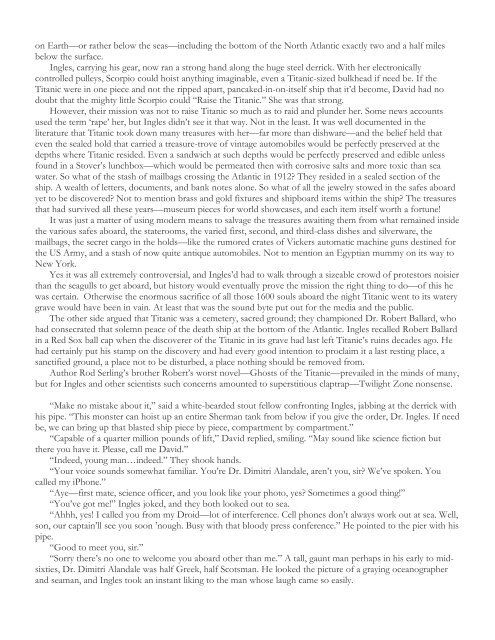Volume Three - WordPress.com — Get a Free Blog Here
Volume Three - WordPress.com — Get a Free Blog Here
Volume Three - WordPress.com — Get a Free Blog Here
Create successful ePaper yourself
Turn your PDF publications into a flip-book with our unique Google optimized e-Paper software.
on Earth<strong>—</strong>or rather below the seas<strong>—</strong>including the bottom of the North Atlantic exactly two and a half miles<br />
below the surface.<br />
Ingles, carrying his gear, now ran a strong hand along the huge steel derrick. With her electronically<br />
controlled pulleys, Scorpio could hoist anything imaginable, even a Titanic-sized bulkhead if need be. If the<br />
Titanic were in one piece and not the ripped apart, pancaked-in-on-itself ship that it’d be<strong>com</strong>e, David had no<br />
doubt that the mighty little Scorpio could “Raise the Titanic.” She was that strong.<br />
However, their mission was not to raise Titanic so much as to raid and plunder her. Some news accounts<br />
used the term ‘rape’ her, but Ingles didn’t see it that way. Not in the least. It was well documented in the<br />
literature that Titanic took down many treasures with her<strong>—</strong>far more than dishware<strong>—</strong>and the belief held that<br />
even the sealed hold that carried a treasure-trove of vintage automobiles would be perfectly preserved at the<br />
depths where Titanic resided. Even a sandwich at such depths would be perfectly preserved and edible unless<br />
found in a Stover’s lunchbox<strong>—</strong>which would be permeated then with corrosive salts and more toxic than sea<br />
water. So what of the stash of mailbags crossing the Atlantic in 1912? They resided in a sealed section of the<br />
ship. A wealth of letters, documents, and bank notes alone. So what of all the jewelry stowed in the safes aboard<br />
yet to be discovered? Not to mention brass and gold fixtures and shipboard items within the ship? The treasures<br />
that had survived all these years<strong>—</strong>museum pieces for world showcases, and each item itself worth a fortune!<br />
It was just a matter of using modern means to salvage the treasures awaiting them from what remained inside<br />
the various safes aboard, the staterooms, the varied first, second, and third-class dishes and silverware, the<br />
mailbags, the secret cargo in the holds<strong>—</strong>like the rumored crates of Vickers automatic machine guns destined for<br />
the US Army, and a stash of now quite antique automobiles. Not to mention an Egyptian mummy on its way to<br />
New York.<br />
Yes it was all extremely controversial, and Ingles’d had to walk through a sizeable crowd of protestors noisier<br />
than the seagulls to get aboard, but history would eventually prove the mission the right thing to do<strong>—</strong>of this he<br />
was certain. Otherwise the enormous sacrifice of all those 1600 souls aboard the night Titanic went to its watery<br />
grave would have been in vain. At least that was the sound byte put out for the media and the public.<br />
The other side argued that Titanic was a cemetery, sacred ground; they championed Dr. Robert Ballard, who<br />
had consecrated that solemn peace of the death ship at the bottom of the Atlantic. Ingles recalled Robert Ballard<br />
in a Red Sox ball cap when the discoverer of the Titanic in its grave had last left Titanic’s ruins decades ago. He<br />
had certainly put his stamp on the discovery and had every good intention to proclaim it a last resting place, a<br />
sanctified ground, a place not to be disturbed, a place nothing should be removed from.<br />
Author Rod Serling’s brother Robert’s worst novel<strong>—</strong>Ghosts of the Titanic<strong>—</strong>prevailed in the minds of many,<br />
but for Ingles and other scientists such concerns amounted to superstitious claptrap<strong>—</strong>Twilight Zone nonsense.<br />
“Make no mistake about it,” said a white-bearded stout fellow confronting Ingles, jabbing at the derrick with<br />
his pipe. “This monster can hoist up an entire Sherman tank from below if you give the order, Dr. Ingles. If need<br />
be, we can bring up that blasted ship piece by piece, <strong>com</strong>partment by <strong>com</strong>partment.”<br />
“Capable of a quarter million pounds of lift,” David replied, smiling. “May sound like science fiction but<br />
there you have it. Please, call me David.”<br />
“Indeed, young man…indeed.” They shook hands.<br />
“Your voice sounds somewhat familiar. You’re Dr. Dimitri Alandale, aren’t you, sir? We’ve spoken. You<br />
called my iPhone.”<br />
“Aye<strong>—</strong>first mate, science officer, and you look like your photo, yes? Sometimes a good thing!”<br />
“You’ve got me!” Ingles joked, and they both looked out to sea.<br />
“Ahhh, yes! I called you from my Droid<strong>—</strong>lot of interference. Cell phones don’t always work out at sea. Well,<br />
son, our captain’ll see you soon ’nough. Busy with that bloody press conference.” He pointed to the pier with his<br />
pipe.<br />
“Good to meet you, sir.”<br />
“Sorry there’s no one to wel<strong>com</strong>e you aboard other than me.” A tall, gaunt man perhaps in his early to midsixties,<br />
Dr. Dimitri Alandale was half Greek, half Scotsman. He looked the picture of a graying oceanographer<br />
and seaman, and Ingles took an instant liking to the man whose laugh came so easily.







